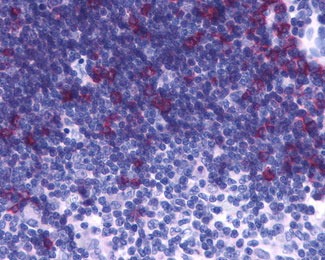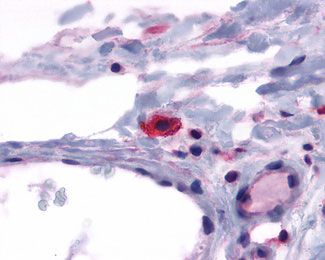GPR44 / CRTH2 Antibody (C-Terminus)
Rabbit Polyclonal Antibody
- SPECIFICATION
- CITATIONS
- PROTOCOLS
- BACKGROUND

Application
| IHC-P, E |
|---|---|
| Primary Accession | Q9Y5Y4 |
| Reactivity | Human |
| Host | Rabbit |
| Clonality | Polyclonal |
| Calculated MW | 43kDa |
| Dilution | IHC-P (15 µg/ml) |
| Gene ID | 11251 |
|---|---|
| Other Names | Prostaglandin D2 receptor 2, Chemoattractant receptor-homologous molecule expressed on Th2 cells, G-protein coupled receptor 44, CD294, PTGDR2, CRTH2, DL1R, GPR44 |
| Target/Specificity | Human GPR44 / CRTH2. BLAST analysis of the peptide immunogen showed no homology with other human proteins, except KCNN2 (50%). |
| Reconstitution & Storage | Long term: -70°C; Short term: +4°C |
| Precautions | GPR44 / CRTH2 Antibody (C-Terminus) is for research use only and not for use in diagnostic or therapeutic procedures. |
| Name | PTGDR2 |
|---|---|
| Synonyms | CRTH2, DL1R, GPR44 |
| Function | Receptor for prostaglandin D2 (PGD2). Coupled to the G(i)- protein. Receptor activation may result in pertussis toxin-sensitive decreases in cAMP levels and Ca(2+) mobilization. PI3K signaling is also implicated in mediating PTGDR2 effects. PGD2 induced receptor internalization. CRTH2 internalization can be regulated by diverse kinases such as, PKC, PKA, GRK2, GPRK5/GRK5 and GRK6. Receptor activation is responsible, at least in part, in immune regulation and allergic/inflammation responses. |
| Cellular Location | Cell membrane; Multi-pass membrane protein. Note=Internalized receptors colocalized with RAB11A. |
| Tissue Location | Widespread expression. High expression in stomach, small intestine, heart and thymus. Intermediate expression in colon, spinal cord and peripheral blood and low expression in brain, skeletal muscle and spleen. Expressed also on Th2- and Tc2- type cells, eosinophils and basophils. |
| Volume | 50 µl |

Thousands of laboratories across the world have published research that depended on the performance of antibodies from Abcepta to advance their research. Check out links to articles that cite our products in major peer-reviewed journals, organized by research category.
info@abcepta.com, and receive a free "I Love Antibodies" mug.
Provided below are standard protocols that you may find useful for product applications.
Background
Receptor for prostaglandin D2 (PGD2). Coupled to the G(i)-protein. Receptor activation may result in pertussis toxin- sensitive decreases in cAMP levels and Ca(2+) mobilization. PI3K signaling is also implicated in mediating PTGDR2 effects. PGD2 induced receptor internalization. CRTH2 internalization can be regulated by diverse kinases such as, PKC, PKA, ADRBK1/GRK2, GPRK5/GRK5 and GRK6. Receptor activation is responsible, at least in part, in immune regulation and allergic/inflammation responses.
References
Marchese A.,et al.Genomics 56:12-21(1999).
Nagata K.,et al.J. Immunol. 162:1278-1286(1999).
Methner A.,et al.Submitted (MAR-1999) to the EMBL/GenBank/DDBJ databases.
King M.M.,et al.Submitted (DEC-2003) to the EMBL/GenBank/DDBJ databases.
Taylor T.D.,et al.Nature 440:497-500(2006).
If you have used an Abcepta product and would like to share how it has performed, please click on the "Submit Review" button and provide the requested information. Our staff will examine and post your review and contact you if needed.
If you have any additional inquiries please email technical services at tech@abcepta.com.













 Foundational characteristics of cancer include proliferation, angiogenesis, migration, evasion of apoptosis, and cellular immortality. Find key markers for these cellular processes and antibodies to detect them.
Foundational characteristics of cancer include proliferation, angiogenesis, migration, evasion of apoptosis, and cellular immortality. Find key markers for these cellular processes and antibodies to detect them. The SUMOplot™ Analysis Program predicts and scores sumoylation sites in your protein. SUMOylation is a post-translational modification involved in various cellular processes, such as nuclear-cytosolic transport, transcriptional regulation, apoptosis, protein stability, response to stress, and progression through the cell cycle.
The SUMOplot™ Analysis Program predicts and scores sumoylation sites in your protein. SUMOylation is a post-translational modification involved in various cellular processes, such as nuclear-cytosolic transport, transcriptional regulation, apoptosis, protein stability, response to stress, and progression through the cell cycle. The Autophagy Receptor Motif Plotter predicts and scores autophagy receptor binding sites in your protein. Identifying proteins connected to this pathway is critical to understanding the role of autophagy in physiological as well as pathological processes such as development, differentiation, neurodegenerative diseases, stress, infection, and cancer.
The Autophagy Receptor Motif Plotter predicts and scores autophagy receptor binding sites in your protein. Identifying proteins connected to this pathway is critical to understanding the role of autophagy in physiological as well as pathological processes such as development, differentiation, neurodegenerative diseases, stress, infection, and cancer.



